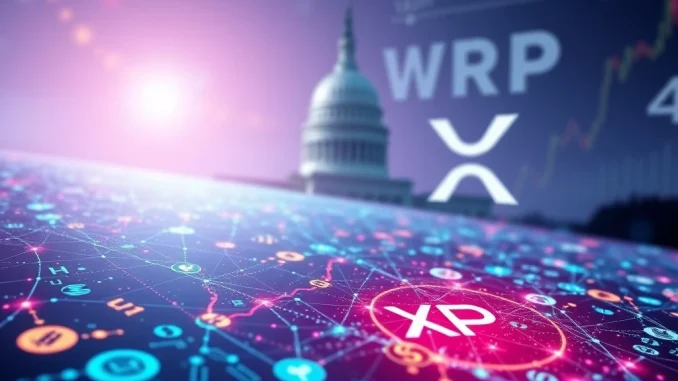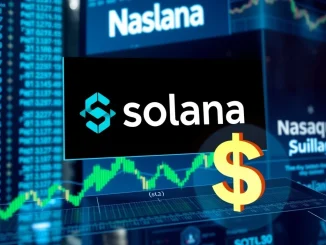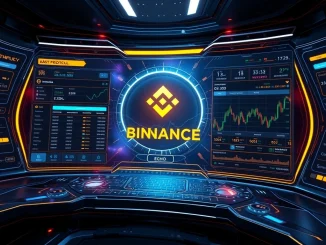
The cryptocurrency world is buzzing, and all eyes are on XRP. In a significant development, the U.S. Deputy Secretary of the Treasury, Michael Faulkender, recently highlighted the transformative potential of Blockchain Technology in global finance. His remarks have sent ripples through the market, particularly exciting XRP proponents who believe Ripple’s XRP Ledger (XRPL) is uniquely positioned to redefine how money moves across borders. This endorsement, coupled with a notable $20 million Institutional Investment and ambitious XRP Price Target predictions, signals a potentially pivotal moment for the digital asset. What does this mean for XRP’s journey, and can it truly become a cornerstone of future global finance?
U.S. Treasury’s Vision for Blockchain Technology
Michael Faulkender’s recent statements have put a spotlight on the inherent advantages of distributed ledger systems. He emphasized their capacity to deliver efficiency, speed, and cost reductions in financial transactions. Faulkender noted that settlements could occur in ‘minutes, if not seconds,’ a stark contrast to traditional systems that often take days. Furthermore, he highlighted enhanced privacy and security as key benefits. This vision aligns perfectly with the core promises of Blockchain Technology and, specifically, with the capabilities of Ripple’s XRP Ledger.
Faulkender also linked the rising demand for U.S. Treasury securities to stablecoin-driven trade. This dynamic could significantly benefit the XRP ecosystem. Ripple’s own RLUSD stablecoin is already integrated into its cross-border solutions, and XRP functions as a bridge asset, facilitating low-cost liquidity transfers between fiat and digital assets. Should stablecoins capture a substantial share of global trade, the demand for assets like XRP could see exponential growth, solidifying its utility.
XRP’s Role in Revolutionizing Cross-Border Payments
For years, the promise of faster, cheaper Cross-Border Payments has been central to XRP’s narrative. Proponents argue that the XRP Ledger (XRPL) is designed to replace legacy systems like SWIFT, which, despite their ubiquity, are often criticized for their slowness and high costs. XRP’s ability to act as a bridge currency allows financial institutions to send money globally without needing pre-funded nostro/vostro accounts, thereby unlocking trapped capital and reducing operational overhead.
The integration of stablecoins, like Ripple’s RLUSD, into this ecosystem further enhances XRP’s utility. These stablecoins can represent fiat currencies on the ledger, with XRP facilitating the seamless, near-instantaneous exchange between them. This creates a highly efficient corridor for international remittances and large-scale corporate transfers, addressing a critical need in global finance that traditional methods struggle to meet efficiently.
Surging Institutional Investment in XRP
Confidence in XRP’s utility isn’t just theoretical; it’s attracting tangible capital. A recent $20 million Institutional Investment by NASDAQ-listed Nature’s Miracle Holding into XRP underscores growing belief in the asset’s long-term value and utility. This move by a publicly traded company signals a broader trend of institutional players exploring digital assets beyond Bitcoin and Ethereum, particularly those with clear use cases in real-world finance.
Such investments are crucial for XRP’s maturation. They provide not only capital but also legitimacy and increased market liquidity. Furthermore, the ongoing speculation about a potential XRP ETF (Exchange-Traded Fund) continues to fuel optimism. An ETF would open the doors for even wider institutional adoption, allowing traditional investors to gain exposure to XRP without directly holding the asset, potentially channeling significant new capital into the ecosystem.
Navigating the Path to a $30 XRP Price Target
The allure of a significant price surge is a powerful motivator for many investors. Some industry observers are projecting an ambitious XRP Price Target of $15 to $30 within the next 12 to 24 months, driven by factors like an eventual XRP ETF and increasing institutional adoption. However, these bullish predictions must be viewed alongside the inherent challenges and market realities.
Achieving a market capitalization equivalent to a $27 XRP price (roughly $1.5 trillion) would require substantial growth and the overcoming of several hurdles. These include navigating complex regulatory landscapes, proving the XRPL’s settlement capabilities at scale, and demonstrating tangible, widespread utility in global finance. Historically, XRP has experienced significant volatility, including a sharp decline from its 2018 peak of $3.45 amidst legal battles, which has understandably tempered some investor optimism. While the technology’s alignment with global payment needs is clear, critics also warn of potential overvaluation risks in an increasingly crowded crypto market.
Latest XRP News: What’s Driving Momentum?
The current momentum in XRP News is multifaceted, driven by a combination of high-level endorsements and concrete financial commitments. Faulkender’s remarks provide a macro-level validation of the underlying blockchain technology that powers XRP. This governmental acknowledgment, even if not directly about XRP, lends credibility to the broader digital asset space and its potential to modernize financial systems.
Simultaneously, the $20 million investment by Nature’s Miracle Holding demonstrates a growing appetite among institutional entities for direct exposure to XRP. This combination of top-down recognition and bottom-up investment is creating a compelling narrative for the asset. In the near term, XRP’s performance will likely continue to reflect broader macroeconomic trends and crypto market cycles. While a gradual trajectory towards a $400 billion to $800 billion market cap (comparable to Bitcoin and Ethereum’s historical gains) remains a realistic long-term outlook, analysts stress that treating XRP as a speculative shortcut to wealth is misguided. Its long-term success hinges on sustained institutional adoption, clear regulatory acceptance, and consistent demand from both retail and institutional investors.
In conclusion, XRP stands at a fascinating juncture. With a U.S. Treasury official advocating for the underlying technology, and significant institutional capital flowing in, the potential for XRP to carve out a dominant role in global Cross-Border Payments appears more tangible than ever. While ambitious price targets capture headlines, the true measure of XRP’s success will be its ability to consistently deliver on its promise of efficient, low-cost global transactions. The journey ahead will undoubtedly involve navigating regulatory complexities and proving its scalability, but the foundations for a transformative impact are steadily being laid.
Frequently Asked Questions (FAQs)
Q1: What is the significance of the U.S. Treasury Deputy Secretary’s comments for XRP?
A1: Michael Faulkender’s comments are significant because they highlight the U.S. Treasury’s recognition of blockchain technology’s potential for efficient and secure cross-border payments. While he didn’t specifically name XRP, his remarks validate the core use case that Ripple and XRP aim to address, lending broader credibility to the underlying technology.
Q2: How does XRP facilitate cross-border payments?
A2: XRP acts as a bridge currency on the XRP Ledger (XRPL). Instead of needing to pre-fund accounts in various currencies globally, financial institutions can convert their local currency to XRP, send the XRP across the ledger almost instantly, and then convert it to the destination currency. This process reduces costs, speeds up transactions, and frees up trapped capital.
Q3: What does the $20 million investment by Nature’s Miracle Holding mean for XRP?
A3: This $20 million institutional investment by a NASDAQ-listed company signifies growing confidence from traditional financial players in XRP’s utility and long-term potential. It brings significant capital into the ecosystem and adds legitimacy, potentially paving the way for more institutional adoption and liquidity.
Q4: Is a $30 XRP price target realistic?
A4: A $30 XRP price target is an ambitious but not impossible projection, often cited by bullish analysts. Achieving it would require a massive increase in market capitalization, necessitating widespread institutional adoption, significant regulatory clarity, and consistent, proven utility in global finance. While the potential exists, it faces substantial challenges and historical volatility.
Q5: What are the main challenges facing XRP’s future growth?
A5: Key challenges include navigating complex and evolving regulatory environments worldwide, proving its scalability and reliability for large-scale financial institutions, and competing in a crowded digital asset market. Overcoming these hurdles will be crucial for XRP to achieve its full potential and widespread adoption.



